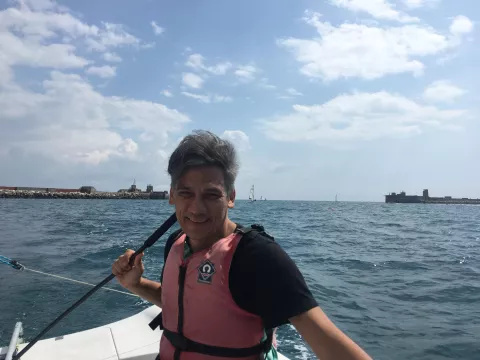All hands on deck to save sailor
Thursday 22 September 2022

Norman recovered after a heart attack during a sailing race
A father who had a heart attack during a sailing competition had his life saved thanks to the quick actions of his crewmate, sailing club members, paramedics and staff across two hospitals.
The swift reactions of everyone involved mean Norman Khine is now recovering with no damage to his heart.
Cloud systems engineer Norman, 52, was taking part in a morning of races at the Queen Mary Sailing Club in Ashford, Surrey on a windy Saturday in late April.
However, after just over an hour of sailing the RS400 sailing dinghy on the reservoir with helmsman Steve Bell, Norman began to feel really unwell.
Norman said: “During the second race, I felt I wanted to throw up and my chest was like it was going to explode.
“It was really windy and I should have been helping Steve with the boat but I couldn’t do anything. I knew if we capsized and I fell in the water, I would be dead.”
Steve managed to battle the weather to single-handedly steer the three-sail dinghy towards a rescue boat which was already on the water.
Retired oil and gas engineer Steve, 70, from Woking, said: “Norman was semi-prone at the bottom of the boat. It was windy and I was struggling to sail the boat on my own but it was clear there was a big problem and I needed to help Norman.
“I was aware that if I did anything wrong or if the boat capsized, it could be terrible. I just really concentrated on keeping control of the boat and getting to the rescue boat, which somehow Norman managed to get on.”
Norman said: “I made a last effort to jump to the rescue boat and the man there managed to help me get in. Then I passed out.”
Norman was taken to the pontoon where staff members and a visitor immediately began resuscitating him and using the club’s defibrillator, whilst on the phone to emergency services.
Dad-of-three Norman, from Purley in South London, said: “Once I got on the rescue boat, I don’t remember anything until I woke up, surrounded by paramedics who were cutting off my wetsuit.”
An ambulance took Norman to a hospital in Surrey for an emergency coronary angioplasty, where a small balloon was inserted into one of Norman’s arteries to widen it and remove any blockages.
Three weeks later, Norman had a heart bypass at St Thomas’ Hospital in central London and scans so far have shown he has no damage to his heart.
Professor Mark O’Neill, Clinical Director for cardiovascular services at Guy’s and St Thomas’ and who was also sailing on the reservoir the same morning, said: “Norman has made an excellent and quite unusual recovery in the circumstances. This is down to the quick responses and the right sort of care by everyone who was with him – from his helmsman to the wonderful club staff, the paramedics and subsequently, the hospitals.
“Knowing what to do in a situation like this and doing it quickly, significantly improves the chances of a person surviving a heart attack and recovering well afterwards.”
Tony Bishop, secretary of the Queen Mary Sailing Club, said the club has had a defibrillator for 10 years and holds regular safety training sessions for staff. Since Norman’s heart attack, the club held a fundraising walk and secured nearly £6,000 to buy two new defibrillators.
He said: “Our staff were really calm on the day, leading the resuscitation until the ambulance arrived. Norman has been a member of our club for years and we will be pleased to see him back on the water, hopefully soon.”
Norman is now building up his strength and has started a phased return to work before returning to sailing soon.
Norman said: “I’m very lucky to be alive and I want to say a huge thank you to everyone who managed to revive me and looked after me on the day and afterwards.
"I’m very grateful to Steve for not capsizing the boat, to the club staff for all they did and to my surgeons for a great job. Everyone at St Thomas’ was really good and very kind, although they were so busy.
“It was surreal the way it happened but I was very fortunate it did happen there at the club. If it had been on the street or when I was at home, I wouldn’t have known what to do.”
What to do if someone has a heart attack or cardiac arrest
A heart attack is a circulatory problem, when a blockage in a blood vessel means the heart can’t pump blood around the body effectively. A cardiac arrest is when there is an electrical problem with the heart, leading to its complete failure to pump. A heart attack can lead to a cardiac arrest, when the person collapses, becomes unresponsive and stops breathing.
Only 1 in 10 people survive an out-of-hospital cardiac arrest in the UK, according to the British Heart Foundation. A fast response can help a person’s chances of survival.
If you are with someone who has a heart emergency, you should:
- Call 999 immediately and ask for an ambulance;
- Help the person to sit on the floor, leaning against a wall if possible;
- The emergency call handler will talk you through how to do chest compressions if needed;
- If there is someone else there, ask them to look for a defibrillator;
- Follow the instructions on the defibrillator. It will only shock a person if needed.
If you are part of an organisation which has a defibrillator, you can register it on the national network.
Last updated: September 2022
Contact us
If you're a journalist and have a media enquiry, please contact us.
Phone: 020 7188 5577
Email: [email protected]



